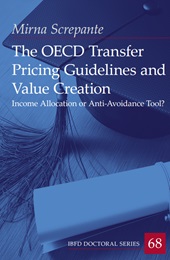The OECD transfer pricing guidelines and value creation : income allocation or anti-avoidance tool?
441 p.
Includes bibliographical references.
This book critically assesses the updated guidance on intangibles outlined in chapters VI and I of the OECD Guidelines. This evaluation is conducted in the context of the base erosion and profit shifting (BEPS) initiative Actions 8-10 Final Reports. The primary objective is to determine the extent to which the modifications introduced in the 2010 OECD Guidelines (now the 2022 OECD Guidelines) align with the OECD's intentions and effectively test the concept of taxation where value is created. The overarching goal is to curtail the artificial tax planning potential associated with the arm's length principle (ALP), which seeks to ensure that multinational corporations pay taxes in line with the economic activities they undertake.
To achieve this, the book delves into the novel concept of value creation and the emphasis on taxation where value is created. It seeks to understand the implications and interpretations of these concepts in the context of the ALP.Additionally, the book aims to anticipate and potentially define any emerging limits on what is considered permissible and impermissible in terms of new tax avoidance strategies. The book highlights the need for a reasonableness test in the ALP to address abnormal or unnecessary value-creating features. This involves scrutinizing whether the modifications can effectively deter the shifting of profits from jurisdictions where economic functions are performed to low-tax regions. In essence, this book contributes to the ongoing discourse on international tax policy and transfer pricing guidelines.
It endeavours to shed light on whether the changes introduced by BEPS, as reflected in the updated OECD Guidelines, will indeed serve as a robust mechanism to combat tax avoidance strategies, thereby aligning taxation more closely with value creation in the global economy.Finally, this book reveals the intricate interplay between the DEMPE concept, Pillar One and the minimum global tax proposed in Pillar Two. Collectively, they establish a comprehensive framework for combating tax avoidance and advancing equity in the realm of taxation. [Publisher's text]
Thesis.
Special access authorizations may apply; please contact us for further information.
-
Informazioni
ISBN: 9789087228651
COLLANA
MATERIE


